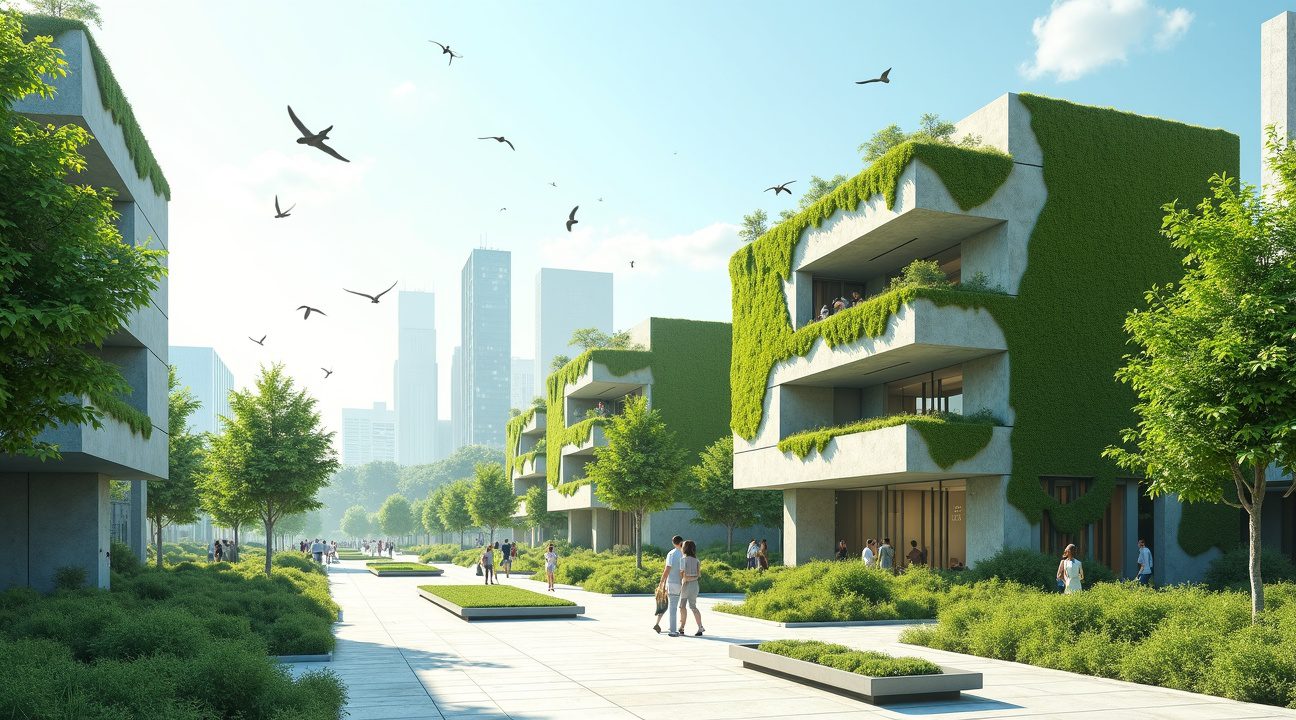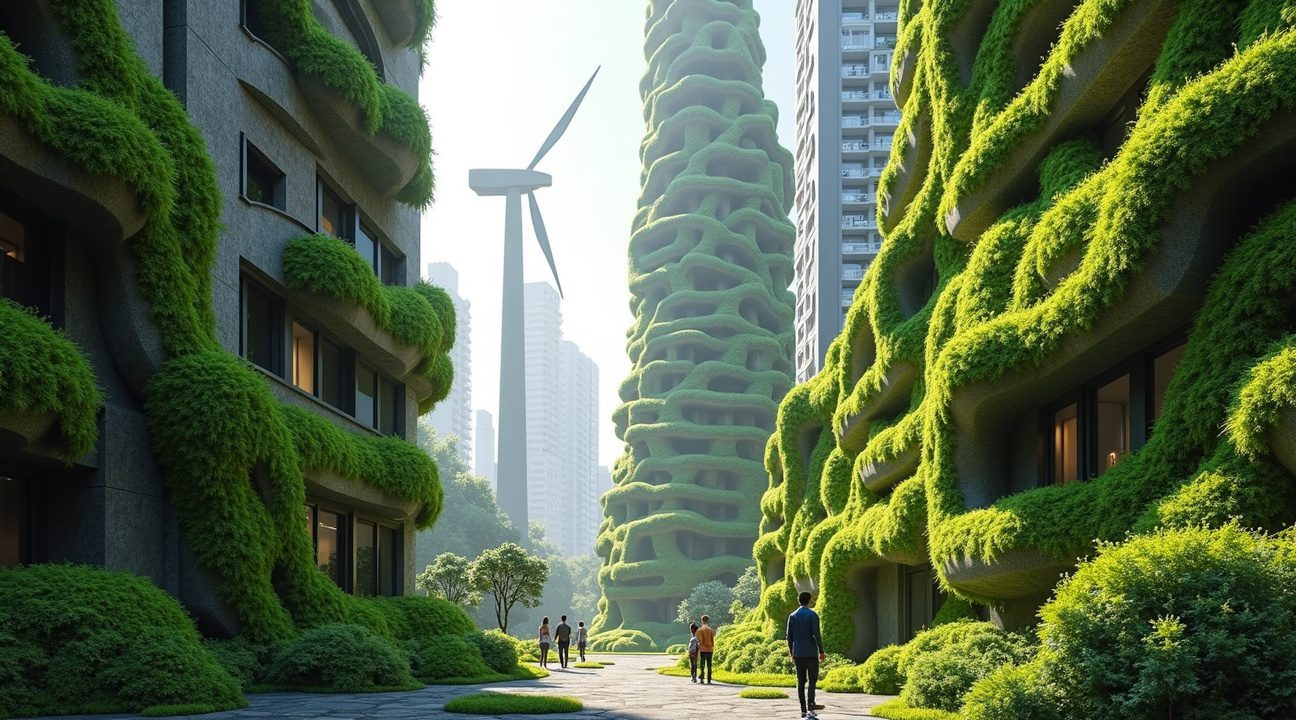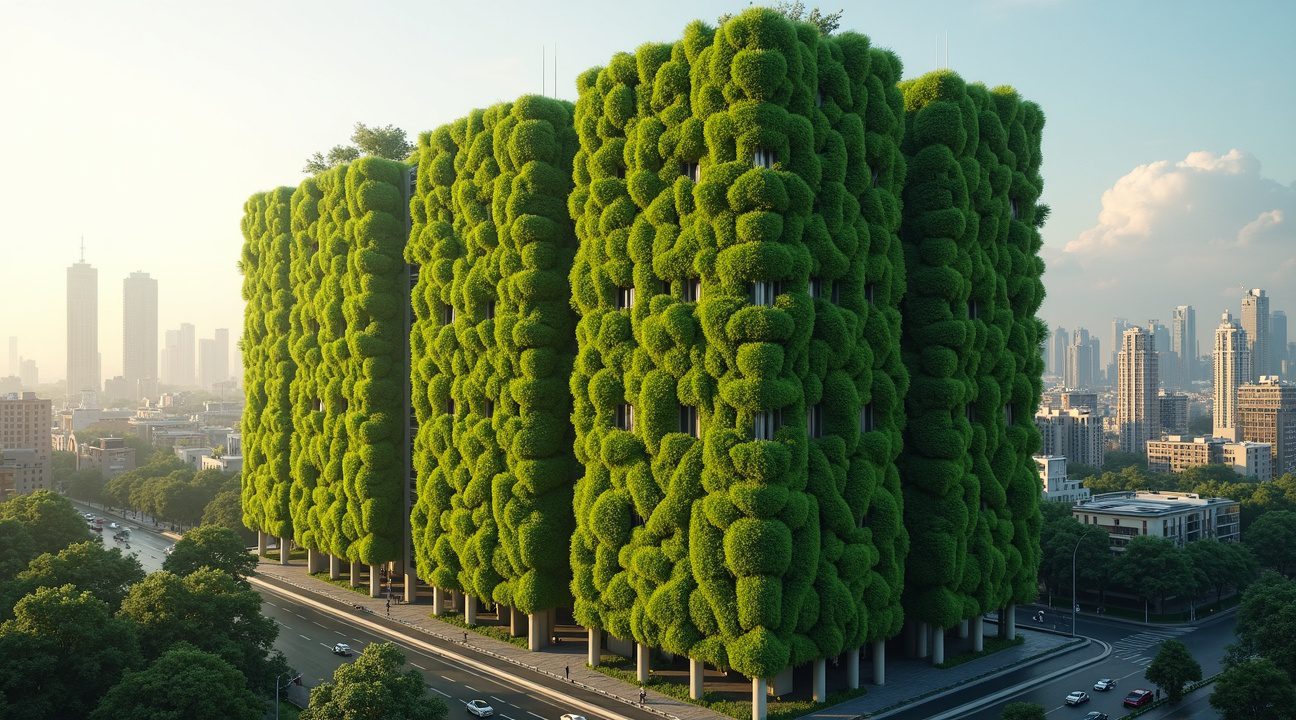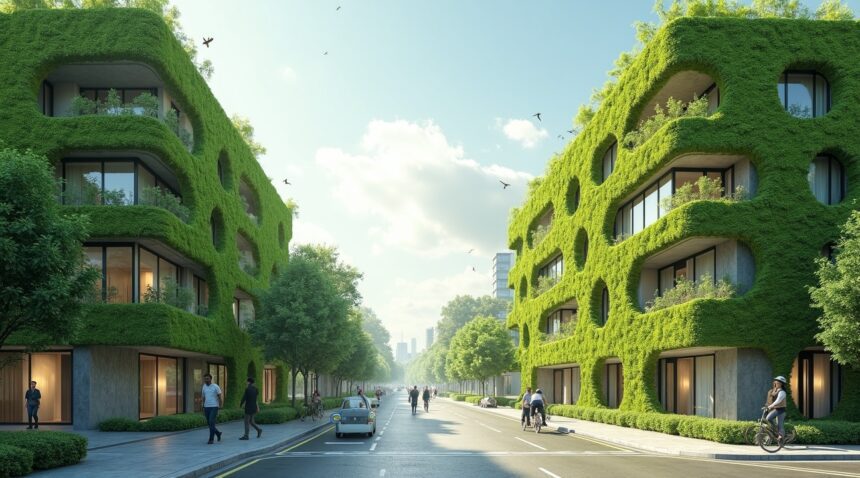Revolutionizing Urban Construction with Moss-Growing Concrete Bricks
Dutch engineers from TU Delft spin-off company Respyre have introduced a groundbreaking innovation—bioreceptive concrete bricks that support moss growth, transforming ordinary walls into living, maintenance-light powerhouses for air purification, cooling, and biodiversity enhancement.
These advanced moss-growing bricks, composed of up to 70% recycled concrete, offer a sustainable alternative to traditional green infrastructure. Designed to last as long as 30 years with minimal upkeep, they enable buildings to passively purify air, regulate temperature, and enhance urban ecosystems.
Key Takeaways
- Revolutionary air purification technology: Moss-covered bricks actively filter harmful particles such as PM 5.5 and PM 0.1, absorb nitrogen oxides, and convert carbon dioxide into oxygen through photosynthesis.
- Sustainable construction material: Created from up to 70% recycled concrete with engineered porosity, these bricks promote moss growth while maintaining durability for up to three decades.
- Natural building cooling system: The moss layer aids in thermal regulation through evapotranspiration and shading, effectively lowering energy consumption and combating urban heat island effects.
- Low-maintenance living walls: Moss thrives using natural moisture and nutrients, eliminating the need for irrigation systems, fertilizers, or regular replacement, unlike traditional green walls.
- Urban biodiversity enhancement: These surfaces encourage micro-ecosystems that attract insects and birds, restoring biodiversity while defending buildings from environmental wear and vandalism.
Multi-Functional Benefits of Moss Bricks
Comprehensive Environmental Impact
This innovation tackles multiple environmental challenges simultaneously. Each brick serves as a self-sustaining mini-ecosystem, utilizing moss’s natural abilities to purify air and regulate temperature. The process of photosynthesis allows moss to capture hazardous urban pollutants while replenishing oxygen levels.
Comparison with Traditional Green Walls
Unlike conventional green wall systems that rely on complex irrigation and maintenance, Respyre’s bricks offer a seamless and sustainable alternative. Engineered concrete surfaces support moss attachment by maintaining proper pH and retaining moisture naturally.
Construction and Installation Advantages
Installation is straightforward using standard masonry methods. These bricks meet typical structural requirements while incorporating substantial recycled content. Textured surfaces encourage moss growth, with colonization visible within weeks post-installation under favorable weather conditions.
Air Quality and Public Health
Through continuous biological filtration, fine particulate matter and gaseous pollutants are absorbed and neutralized. Given the threat of airborne particulates in urban centers, this natural filtration method offers a low-tech, high-impact solution.
Thermal Regulation and Energy Efficiency
As moss undergoes evapotranspiration, it releases moisture that cools the surrounding air. This effect not only reduces dependency on climate control systems indoors, but also contributes to alleviating urban heat island symptoms.
Minimal Maintenance Requirements
This system eliminates the need for extensive upkeep. Moss adjusts its growth according to available resources, removing the financial and environmental costs associated with irrigation and replanting associated with other green wall technologies.
Long-Term Economic Value
With a projected lifespan of 30 years, moss bricks offer exceptional return on investment. Reduced energy consumption and decreased maintenance lead to substantial long-term cost savings for property owners.
Ecological and Aesthetic Contributions
As moss habitats flourish, they attract beneficial insects and birds, bolstering local biodiversity. These green surfaces also resist climate-related wear and vandalism, offering both protection and beauty. Studies have shown that graffiti is less likely on planted or moss-covered walls due to their living aesthetic.
Architectural Flexibility and Reliable Manufacturing
Architects can embed these bricks into diverse structures—from facades and retaining walls to artistic features. Quality control ensures that every batch maintains consistent chemical and structural properties, optimizing moss establishment regardless of climate.
Impact on Climate Change and Future Innovations
These bricks contribute actively to climate mitigation by sequestering atmospheric carbon and reducing reliance on energy-dependent cooling systems. Future enhancements include identifying robust moss species for various urban conditions, improving concrete blends, and potentially incorporating smart systems for monitoring energy and air-quality performance.
For more about Respyre’s innovation, visit their official company website.
https://www.youtube.com/watch?v=KCilPNabGcFDTM
Revolutionary Bioreceptive Concrete Transforms Buildings into Living Air Purifiers
Dutch engineers have created a groundbreaking solution that transforms ordinary buildings into active environmental cleaners through innovative bioreceptive concrete technology. Led by TU Delft spin-off company Respyre, these engineers developed specialized bricks and coatings that naturally support moss growth on building surfaces, creating living walls that actively purify air and combat urban pollution.
How Bioreceptive Concrete Works as Nature’s Air Filter
The moss-growing bricks function as natural air purification systems, delivering multiple environmental benefits that traditional building materials simply can’t match. These living surfaces actively absorb carbon dioxide from the atmosphere while simultaneously filtering harmful pollutants from urban air. The moss creates a cooling effect on buildings, reducing energy costs and urban heat island effects that plague modern cities.
Beyond air purification, these innovative surfaces enhance urban biodiversity by providing habitat for moss and other microorganisms. The technology addresses several critical urban challenges through a single, elegant solution that integrates seamlessly with existing architectural designs.
Respyre’s bioreceptive concrete stands apart from conventional building materials through its unique composition and engineering. The material contains up to 70% recycled concrete, making it an environmentally responsible choice that reduces construction waste. Engineers specifically designed the surface with high porosity, creating ideal conditions for moss colonization while maintaining structural integrity.
The engineered surface promotes long-term durability with an impressive lifespan of up to 30 years. This extended durability ensures that building owners can enjoy decades of environmental benefits without frequent replacement or major maintenance interventions.
Unlike traditional concrete surfaces that resist biological growth, bioreceptive concrete actively encourages moss development without compromising the building’s structural integrity. The moss grows naturally on these surfaces without causing damage or deterioration that typically occurs when vegetation colonizes conventional building materials.
Property owners don’t face increased maintenance burdens with this technology. The moss-covered surfaces actually require less intervention than traditional building exteriors while providing continuous environmental benefits. This represents a significant shift from viewing biological growth on buildings as a problem to embracing it as a solution.
The innovation demonstrates how modern engineering can work with natural processes rather than against them. Similar to how space exploration advances push technological boundaries, this bioreceptive concrete technology pushes the boundaries of sustainable construction.
These moss-growing bricks offer architects and urban planners a practical tool for creating healthier, more sustainable cities. The technology transforms every treated building surface into an active participant in environmental restoration, proving that innovative engineering solutions can address multiple urban challenges simultaneously while maintaining aesthetic appeal and structural performance.

The Science Behind Self-Sustaining Moss Growth on Building Facades
Dutch engineers have developed an innovative approach to green architecture that harnesses the natural resilience of moss through carefully engineered brick systems. These specialized bricks create an ideal microenvironment for moss cultivation by incorporating specific design elements that support sustained plant growth without extensive maintenance requirements.
The foundation of this technology lies in engineered porosity that allows the bricks to retain moisture while providing adequate drainage. Surface microtexture creates numerous attachment points for moss establishment, while carefully calibrated acidity levels ensure optimal growing conditions. Integrated nutrients within the brick matrix provide essential elements that moss requires for healthy development and long-term survival.
Unique Attachment Mechanisms and Non-Invasive Growth
Moss differs significantly from other plants in how it interacts with building surfaces. Instead of traditional root systems that could potentially damage structures, moss uses rhizoids – hair-like structures that function primarily for attachment and nutrient absorption. These rhizoids don’t penetrate deeply into materials, making moss an ideal candidate for facade applications where structural integrity must be maintained.
The rhizoid system allows moss to:
- Secure itself to textured brick surfaces without causing damage
- Absorb water and nutrients directly from the surrounding environment
- Maintain stable growth patterns without expanding root networks
- Adapt to varying surface conditions while remaining firmly attached
This unique biological characteristic eliminates concerns about structural damage that often accompany other green building solutions. Building owners can implement moss brick systems without worrying about root infiltration or long-term facade deterioration.
Unlike conventional vertical garden systems that demand extensive irrigation networks, regular fertilization schedules, and ongoing horticultural expertise, moss bricks operate with minimal intervention. The self-sustaining nature of these systems stems from moss’s remarkable ability to enter dormancy during unfavorable conditions and rapidly resume growth when moisture returns.
Mosses demonstrate exceptional tolerance to environmental extremes, including drought periods, temperature fluctuations, and varying light conditions. This resilience makes them particularly suitable for green architecture applications in regions with unpredictable weather patterns. When moisture becomes scarce, moss can remain dormant for extended periods without dying, then quickly reactivate when conditions improve.
The low-maintenance aspect extends beyond basic survival. These systems typically require only periodic cleaning and occasional assessment of moss coverage density. Property managers don’t need specialized knowledge or expensive equipment to maintain effective moss growth on building facades.
Temperature regulation represents another significant advantage of moss brick systems. The living moss layer creates an insulating effect that helps moderate building temperatures throughout seasonal changes. During summer months, evapotranspiration from the moss provides natural cooling, while in winter, the moss layer adds thermal insulation that can reduce heating costs.
The engineered brick design ensures optimal water retention without creating waterlogged conditions that could promote unwanted microorganism growth. Strategic spacing and drainage channels prevent excess moisture accumulation while maintaining adequate hydration for sustained moss development.
This technology represents a significant advancement in sustainable building practices, offering property owners an environmentally beneficial solution that requires minimal ongoing investment. The combination of natural moss resilience and engineered brick design creates a system that can function effectively across diverse climate conditions while providing measurable environmental benefits including air purification and carbon absorption.
Similar innovations in space exploration have shown how sustainable technologies can revolutionize traditional approaches to complex challenges, demonstrating the potential for biological solutions in engineering applications.
How Moss Bricks Filter Air and Combat Urban Pollution
I’ve discovered that moss bricks represent a breakthrough in urban air purification technology, functioning as natural atmospheric filters that actively combat multiple forms of pollution. These innovative building materials harness the biological processes of moss to create a living system that continuously cleans the air around buildings.
Active Filtration and Particle Capture
Moss surfaces work as sophisticated biological filters, capturing harmful particulate matter including PM 5.5 and PM 0.1 particles that pose serious health risks in urban environments. The moss structure traps these microscopic pollutants and incorporates them into its phytomass, ensuring that captured particles don’t return to the atmosphere. This permanent sequestration sets moss bricks apart from conventional air filtration systems that require regular maintenance and filter replacements.
Air purification extends beyond particle capture to include the removal of nitrogen oxides (NOx) and other harmful compounds commonly found in city air. Fine dust particles smaller than 6 micrometers, which easily penetrate human respiratory systems, become trapped within the moss matrix. This natural filtration process operates continuously without energy consumption, making it an efficient solution for improving urban air quality.
Carbon Capture Through Photosynthesis
Carbon dioxide absorption represents another critical function of moss bricks, as these living walls actively convert atmospheric CO₂ into oxygen through photosynthesis. This biological process occurs throughout daylight hours, providing a steady source of fresh oxygen while reducing carbon concentrations in the immediate environment. Research into biological systems continues to reveal new possibilities for natural air purification methods.
Current investigations focus on quantifying the long-term carbon offset potential of moss brick installations. Early findings suggest that large-scale deployment could contribute meaningfully to urban carbon reduction goals, though researchers continue studying the cumulative impact across different climate conditions and moss species.
The dual functionality of moss bricks provides both passive and active atmospheric cleansing. Passive filtration occurs through physical particle capture, while active processes involve the metabolic conversion of pollutants into harmless or beneficial compounds. This combination creates a comprehensive air treatment system that addresses multiple pollution sources simultaneously.
Buildings equipped with moss brick facades essentially function as large-scale air purifiers, continuously processing the surrounding atmosphere. The technology offers particular value in densely populated areas where traditional green spaces can’t adequately address air quality challenges. Integration into existing urban infrastructure requires minimal modification while delivering measurable improvements in local air conditions.
Cooling Buildings and Creating Urban Biodiversity Havens
Dutch engineers have developed moss-growing bricks that tackle two critical urban challenges simultaneously: excessive heat and declining biodiversity. These innovative building materials transform lifeless concrete surfaces into living ecosystems that actively cool buildings while providing essential habitat for urban wildlife.
Temperature Reduction Through Natural Cooling Mechanisms
Moss bricks combat urban heat through multiple cooling strategies that conventional building materials can’t match. The moss covering shields building surfaces from direct sunlight, preventing heat absorption that typically radiates back into the surrounding environment. This natural shading effect significantly reduces surface temperatures compared to traditional brick or concrete facades.
Evapotranspiration provides an additional cooling mechanism that sets moss bricks apart from standard materials. The moss continuously releases moisture into the air through this biological process, creating a localized cooling effect similar to how trees naturally lower ambient temperatures. Moss panels retain water within their structure and release it gradually, maintaining consistent cooling throughout the day.
Maintenance managers have documented that buildings with moss-coated facades experience extended lifespan due to temperature regulation. The moss layer protects underlying materials from thermal expansion and contraction cycles that typically cause cracking and deterioration over time.
Enhancing Urban Biodiversity
Beyond temperature control, moss bricks create vital habitat opportunities in urban environments where green spaces are limited. These living surfaces support insect populations that previously had no suitable habitat on sterile building facades. The moss provides food sources and shelter for various small organisms, establishing micro-ecosystems on vertical surfaces throughout the city.
Urban biodiversity benefits extend beyond insects, as these habitats attract birds and other wildlife that feed on the supported insect populations. Previously lifeless building surfaces become active contributors to urban food webs, connecting fragmented green spaces across the cityscape.
The dual-purpose nature of moss bricks addresses pressing environmental concerns that cities face worldwide:
- Heat island effects that make urban areas significantly warmer than surrounding regions receive direct mitigation through widespread adoption of these cooling surfaces.
- Biodiversity loss in urban areas gets counteracted through the creation of numerous small habitats that collectively support substantial wildlife populations.
Buildings equipped with moss brick facades contribute to broader environmental goals while reducing energy costs for property owners. The cooling effects decrease reliance on air conditioning systems, while the biodiversity benefits align with urban sustainability initiatives. Much like how space exploration innovations push technological boundaries, these moss bricks represent a breakthrough in sustainable urban design that addresses multiple environmental challenges through a single innovative solution.
https://www.youtube.com/watch?v=KCilPNabGcFDTM
Sustainable Installation and Minimal Maintenance Requirements
Installation flexibility stands as one of the most compelling advantages of moss-growing bricks. These innovative surfaces can be mounted on new constructions, retrofitted to existing buildings, added to residential balconies, or even applied to industrial infrastructure like wind turbine bases. The adaptability makes them suitable for virtually any vertical surface where air purification and cooling benefits are desired.
Long-Term Durability and Protective Benefits
Moss bricks offer exceptional longevity through their construction from upcycled or recycled concrete materials. Respyre’s surfaces maintain effectiveness for up to 30 years, providing building owners with a long-term investment in both environmental performance and structural protection. The moss layer creates a protective barrier that shields underlying surfaces from harsh weather conditions, preventing deterioration while simultaneously defending against graffiti vandalism.
Building lifespans extend significantly when protected by these living barriers. The moss absorbs moisture fluctuations and temperature variations that would otherwise stress traditional building materials. Property owners find this dual function particularly valuable, as the system pays for itself through reduced maintenance costs and extended structural integrity.
Self-maintenance capabilities set moss bricks apart from traditional green building solutions. Most climates provide sufficient natural conditions for the moss to thrive without human intervention. The organisms naturally regulate their growth patterns and adapt to seasonal changes, requiring only occasional manual adjustments during extreme weather periods.
Water usage remains minimal compared to conventional green walls and intensive rooftop gardens. Traditional vertical gardens demand complex irrigation systems, pumps, and regular water supply monitoring. Moss bricks eliminate these infrastructure requirements by relying primarily on natural precipitation and atmospheric moisture. This approach significantly reduces both installation costs and ongoing operational expenses.
Installation complexity decreases dramatically when choosing moss bricks over alternative green building systems. Property owners avoid the need for structural reinforcement, complex plumbing networks, or specialized drainage systems. The lightweight nature of the moss-covered concrete allows for straightforward mounting without extensive engineering assessments or building modifications.
Maintenance schedules become remarkably simple with moss brick installations. Unlike space exploration technologies that require constant monitoring, these living systems operate independently once established. Building managers typically inspect the surfaces quarterly to ensure proper moss coverage and remove any debris that might accumulate in crevices.
The economic advantages compound over time as maintenance costs remain consistently low. Traditional green walls often require plant replacement, fertilization, pest control, and irrigation system repairs. Moss bricks eliminate most of these recurring expenses while delivering comparable or superior air purification results.
Industrial applications demonstrate the system’s versatility and durability. Wind turbine installations have successfully integrated moss bricks to improve local air quality while protecting equipment housing from environmental damage. These harsh outdoor environments prove the technology’s resilience and practical value across diverse settings.
Temperature regulation occurs naturally through the moss layer’s evapotranspiration process. Buildings experience reduced cooling loads during hot weather as the moss releases moisture and creates localized temperature drops. This passive cooling effect reduces energy consumption without requiring mechanical systems or electrical input.
Climate adaptability ensures successful installations across various geographic regions. Moss species selection can be customized for local conditions, allowing the system to function effectively in both humid coastal areas and drier inland locations. The biological components adjust their activity levels based on available moisture and seasonal patterns.
Property value increases often result from moss brick installations due to their environmental benefits and aesthetic appeal. Building owners report positive responses from tenants and visitors who appreciate the visible commitment to sustainability. The combination of air purification, building protection, and energy efficiency creates multiple value propositions that justify the initial investment.

Long-Term Durability and Environmental Protection Benefits
I’ve observed how these innovative moss bricks create a protective shield that extends far beyond their air-cleaning capabilities. The living moss layer acts as a natural barrier, protecting the underlying building materials from harsh weather conditions, acid rain, and urban pollutants that typically cause facades to deteriorate over time. This protective coating significantly reduces maintenance requirements while preserving the structural integrity of buildings for decades.
Sustainable Material Recovery and Installation
The engineering brilliance lies in how these bricks repurpose waste concrete, transforming what would be landfill material into functional building components. I find this approach particularly impressive because it addresses two environmental challenges simultaneously – waste reduction and urban air quality improvement. Installation requires minimal disruption to existing infrastructure, making it feasible for both new construction and retrofitting projects. Unlike complex space exploration technologies that demand extensive modifications, these moss bricks integrate seamlessly into standard construction practices.
Self-Maintaining Properties and Cost Efficiency
The self-maintaining characteristics of moss bricks represent a significant advantage over traditional green building technologies. I’ve learned that once established, the moss requires minimal intervention, relying primarily on natural moisture and nutrients from the air. This autonomous operation translates to substantial cost savings over time, as building owners avoid the recurring expenses associated with:
- Regular cleaning and maintenance schedules
- Replacement of mechanical air filtration systems
- Facade restoration due to environmental damage
- Energy costs for cooling systems during hot weather
The moss coating naturally regulates temperature, reducing the building’s cooling load during summer months while providing insulation benefits year-round. This thermal regulation contributes to lower energy consumption, making the investment economically viable over the building’s lifetime. The extended lifespan of protected facades means fewer renovation cycles, reducing both financial costs and environmental impact from construction activities.

Sources:
TU Delft Innovation Impact – “Respyre’s green concrete breathes new life into the city”
Michele Gargiulo Blog – “The Building That Breathes: How Moss Bricks Are Changing the Future of Architecture”
Positive News – “This company is helping cities breathe by covering walls with moss”
The Plan Journal – “Moss as a Multifunctional Material for Technological Greenery Systems”
IO+ – “Auke Bleij wants cities to breathe through moss-covered facades”


